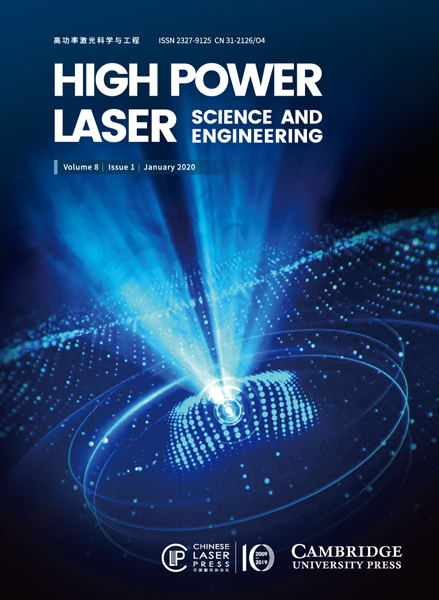2021, 9(1) Column
High Power Laser Science and Engineering 第9卷 第1期
In this paper, we report the study of degradation for a kind of ideal mandrel material called poly-α-methylstyrene based on theoretical and experimental methods. First-principles calculations reveal two types of process: depolymerization and hydrogen-transfer-induced chain scission. The energy barrier for the former (0.68–0.82 eV) is smaller than that for most of the latter (1.39–4.23 eV). More importantly, reaction rates suggest that the former is fast whereas the latter is mostly slow, which can result in a difference of 5–31 orders of magnitude at 550 K. Furthermore, a thermogravimetric experiment shows that the activation energy of 2.53 eV for degradation is between those of fast and slow processes, corresponding to the theoretical average value of multiple reaction paths. Thus, a mandrel degradation model combining fast and slow processes is established at the atomic level. Our work provides a direction for research into the key technology of target fabrication in inertial confinement fusion.
atomic level degradation first principles mandrel material thermogravimetric experiment Magnetic field annihilation and charged particle acceleration in ultra-relativistic laser plasmas Download:701次
Download:701次
 Download:701次
Download:701次Magnetic reconnection driven by laser plasma interactions attracts great interests in the recent decades. Motivated by the rapid development of the laser technology, the ultra strong magnetic field generated by the laser-plasma accelerated electrons provides unique environment to investigate the relativistic magnetic field annihilation and reconnection. It opens a new way for understanding relativistic regimes of fast magnetic field dissipation particularly in space plasmas, where the large scale magnetic field energy is converted to the energy of the nonthermal charged particles. Here we review the recent results in relativistic magnetic reconnection based on the laser and collisionless plasma interactions. The basic mechanism and the theoretical model are discussed. Several proposed experimental setups for relativistic reconnection research are presented.
laboratory astrophysics laser plasmas interactions particle acceleration high energy density physics In this work we present experimental results on the behavior of diamond at megabar pressure. The experiment was performed using the PHELIX facility at GSI in Germany to launch a planar shock into solid multi-layered diamond samples. The target design allows shock velocity in diamond and in two metal layers to be measured as well as the free surface velocity after shock breakout. As diagnostics, we used two velocity interferometry systems for any reflector (VISARs). Our measurements show that for the pressures obtained in diamond (between 3 and 9 Mbar), the propagation of the shock induces a reflecting state of the material. Finally, the experimental results are compared with hydrodynamical simulations in which we used different equations of state, showing compatibility with dedicated SESAME tables for diamond.
carbon dynamic compression equation of state shock wave VISAR Highly efficient difference-frequency generation for mid-infrared pulses by passively synchronous seeding Download:934次
Download:934次
 Download:934次
Download:934次We have proposed and experimentally demonstrated a novel scheme for efficient mid-infrared difference-frequency generation based on passively synchronized fiber lasers. The adoption of coincident seeding pulses in the nonlinear conversion process could substantially lower the pumping threshold for mid-infrared parametric emission. Consequently, a picosecond mid-infrared source at 3.1 μm was prepared with watt-level average power, and a maximum power conversion efficiency of 77% was realized from pump to down-converted light. Additionally, the long-term stability of generated power was manifested with a relative fluctuation as low as 0.17% over one hour. Thanks to the all-optical passive synchronization and all-polarization-maintaining fiber architecture, the implemented laser system was also featured with simplicity, compactness and robustness, which would favor subsequent applications beyond laboratory operation.
mid-infrared fiber laser nonlinear optics difference-frequency generation Optical control of transverse motion of ionization injected electrons in a laser plasma accelerator Download:767次
Download:767次
 Download:767次
Download:767次We demonstrate an all-optical method for controlling the transverse motion of an ionization injected electron beam in a laser plasma accelerator by using the transversely asymmetrical plasma wakefield. The laser focus shape can control the distribution of a transversal wakefield. When the laser focus shape is changed from circular to slanted elliptical in the experiment, the electron beam profiles change from an ellipse to three typical shapes. The three-dimensional particle-in-cell simulation result agrees well with the experiment, and it shows that the trajectories of these accelerated electrons change from undulating to helical. Such an all-optical method could be useful for convenient control of the transverse motion of an electron beam, which results in synchrotron radiation from orbit angular momentum.
electron beam laser plasma transverse motion wakefield acceleration Reflecting petawatt lasers off relativistic plasma mirrors: a realistic path to the Schwinger limit Download:1007次
Download:1007次
 Download:1007次
Download:1007次The quantum vacuum plays a central role in physics. Quantum electrodynamics (QED) predicts that the properties of the fermionic quantum vacuum can be probed by extremely large electromagnetic fields. The typical field amplitudes required correspond to the onset of the ‘optical breakdown’ of this vacuum, expected at light intensities >4.7×1029 W/cm2. Approaching this ‘Schwinger limit’ would enable testing of major but still unverified predictions of QED. Yet, the Schwinger limit is seven orders of magnitude above the present record in light intensity achieved by high-power lasers. To close this considerable gap, a promising paradigm consists of reflecting these laser beams off a mirror in relativistic motion, to induce a Doppler effect that compresses the light pulse in time down to the attosecond range and converts it to shorter wavelengths, which can then be focused much more tightly than the initial laser light. However, this faces a major experimental hurdle: how to generate such relativistic mirrors? In this article, we explain how this challenge could nowadays be tackled by using so-called ‘relativistic plasma mirrors’. We argue that approaching the Schwinger limit in the coming years by applying this scheme to the latest generation of petawatt-class lasers is a challenging but realistic objective.
ultraintense laser-matter interaction strong-field quantum electrodynamics plasma mirrors attosecond light pulses David Neely was an internationally recognised scientist who formed collaborations and friendships across the world. His passion for his work always shone through. He always made time for early-career scientists and became a mentor and supervisor to many. He was an active Editorial Board Member of the international journal High Power Laser Science and Engineering. Sadly, David was taken from us much too early. In this Editorial we pay tribute to his work through his publications in the journal.
Editorial David Neely tribute Up conversion and excited state absorption analysis in the Tm:YAG disk laser multi-pass pumped by 1 μm laser Download:537次
Download:537次
 Download:537次
Download:537次We present a 2 μm Tm:YAG disk laser multi-pass pumped by a 1 μm laser. The transitions in competition of up conversion (UC) and excited state absorption (ESA) are analyzed in detail based on a numerical model that considers stimulated emission, fluorescence, non-radiative decay, UC, andESA, showing good agreement with experiments. The proportions and fractional thermal loads of all transitions are derived quantitatively. The results show that UC and ESA are critical in Tm:YAG disk lasers, resulting in a decrease in the absorbed pump power and temperature after lasing for two different disk thicknesses. In addition, although the absorbed pump power of the 0.5 mm disk is lower than in the 1 mm case, its relatively weak UC and ESA and low total fractional thermal load can improve laser performance. A 0.5 mm Tm:YAG disk laser thus delivered the maximum output power of1.05 W with beam quality of Mx2 = 2.02 and My2 = 2.03.
mid-infrared laser thermal effects thulium In this paper, we present a reanalysis of the silicon He-$\mathrm{\alpha}$ X-ray spectrum emission in Fujioka et al.’s 2009 photoionization experiment. The computations were performed with our radiative-collisional code, RCF. The central ingredients of our computations are accurate atomic data, inclusion of satellite lines from doubly excited states and accounting for the reabsorption of the emitted photons on their way to the spectrometer. With all these elements included, the simulated spectrum turns out to be in good agreement with the experimental spectrum.
high-energy-density physics laboratory astrophysics laser–plasma interaction 动态信息
动态信息 丨 2023-06-21
HPL Highlight (Vol. 11, e40): NIF仍然是全球唯一一个能够进行ICF点火实验的装置动态信息 丨 2023-06-21
HPL Highlight (Vol. 11, e9): 变分神经网络预测激光尾波场加速电子能谱动态信息 丨 2023-06-21
HPL Highlight (Vol. 11, e7): 目标探测网络加入,激光等离子体加速器实现实时诊断动态信息 丨 2023-06-21
HPL Highlight (Vol. 11, e5): 910 nm波段超宽带种子源,向100 PW超强超短激光进发动态信息 丨 2023-06-21
HPL Highlight (Vol. 11, e4): 100 PW单束压缩!多步压缩器进阶双光栅激光评论微信公众号

点击菜单“联系编辑”即可添加期刊编辑为好友啦













